These parks in Texas, California, Utah and other states are perfect for a visit during the cooler months.
When people plan their national parks vacations, they typically don’t target the winter season. But the low-traffic cooler months are actually a perfect time to visit many parks across the U.S.
“Winter is such an underrated time of year to visit the national parks if you’re willing to put in some extra time planning around seasonal closures and packing those winter clothes,” Jim Pattiz, co-founder of the organization More Than Just Parks, told HuffPost.
Of course, some parks are better suited for winter visits than others. We asked experts to share the national parks they believe are best to explore during the winter season.
Sequoia National Park
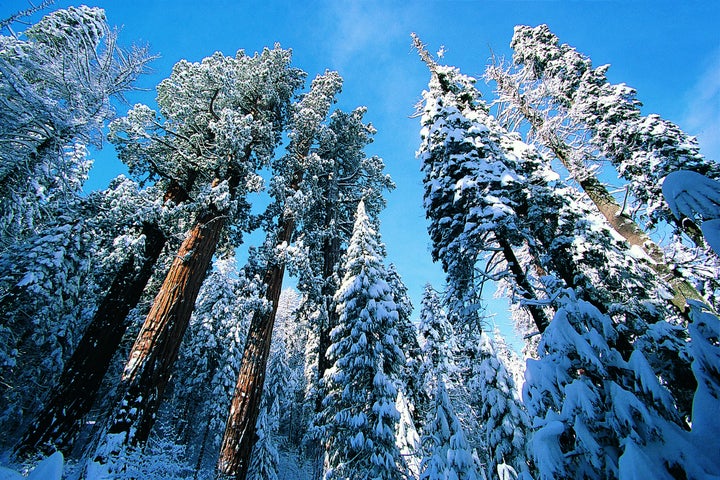
“Without a doubt my favorite national park to visit in the winter is Sequoia National Park in California,” Pattiz said. “Walking through a grove of the park’s magnificent giant sequoias draped in feet of white snow is truly an awe-inspiring experience. The crowds and frequent wildfires of summer are long gone here and replaced by the serene quiet of snow dropping from overburdened branches and the wind gently passing through the giant trees’ upper canopies.”
He noted that many of the park’s roads are closed seasonally, so it’s important to check the website ahead of time to ensure you can reach the specific destinations you want to visit.
“Be flexible and bring your best winter clothing!” Pattiz added.
Everglades National Park
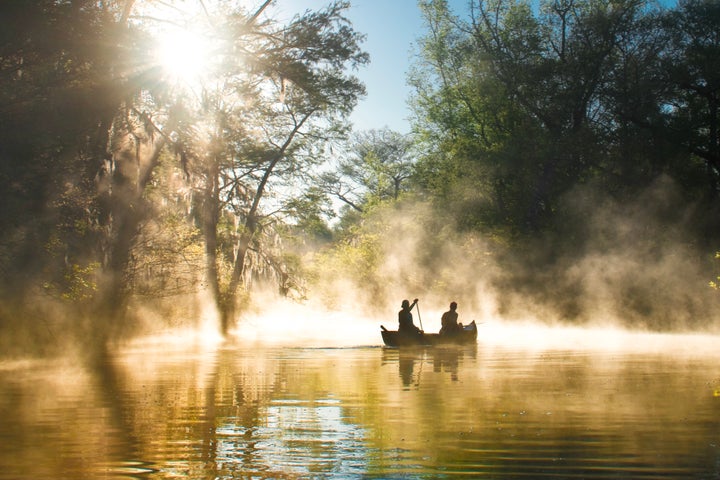
“So many people make Florida their summer vacation spot because it’s a convenient time for a family getaway. However, it is not a good time to visit Everglades National Park,” said national parks travel expert Mikah Meyer.
This impressive wetlands ecosystem is located just outside Miami, and as Meyer alluded to, the area’s summer heat, humidity and swarms of mosquitos make it less enjoyable to visit during that time of year compared to other months.
“Having spent time in every section of the park in January, I can confirm it is an entirely different ― and pleasant ― experience,” he said. “The lower temperatures make every activity more enjoyable, including it being more comfortable to wear long pants on a muddy ‘slough slog’ hike to a cypress dome.”
Airboat rides feel less blistering in the sun during this time of year, and there’s a nice coolness in the air as you watch dolphins in the southwest section.
“It also means you’ll be less dehydrated during a Shark Valley Tram Tour, and in general will make you want to spend more time admiring the park’s multitude of wildlife than rushing back to the AC of your car,” Meyer said. “While there are other nearby national parks to Miami, Biscayne Bay and Dry Tortugas, both of these are less enjoyable in the winter because they are so heavily reliant upon water activities. The ocean water is cold during this time of year, which also takes away recreation options at the beach.”
Yellowstone National Park
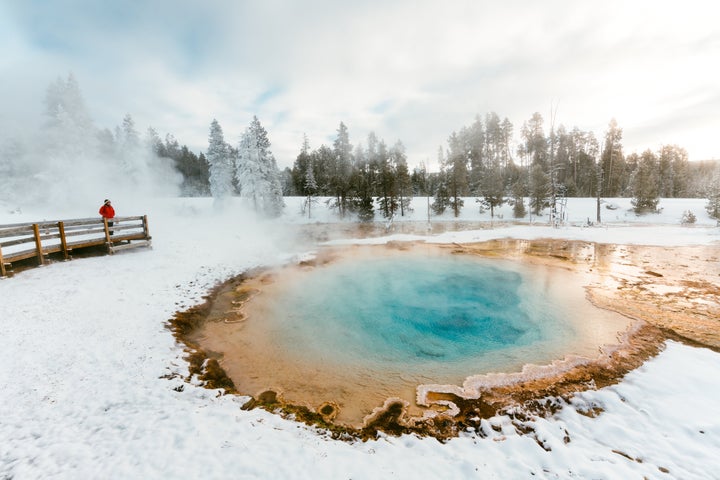
“Yellowstone is one of the best parks to visit in the winter because it offers a unique glimpse at the world’s first national park,” said Jack Steward, co-host of the “Rock the Park” TV series. “The park has a quieter, less active feel in the winter, and with the bears hibernating, you can really sense the stillness in the air.”
The winter provides rare opportunities for exploration with fewer crowds and incredible snowy vistas, creating the sense that you’re the only people in the vast landscape.
“You can’t drive through or [camp] inside the park in winter,” said Joe Yogerst, travel expert and author of National Geographic’s “50 States, 500 Campgrounds.” “But you can hop a snowcoach or snowmobile tour or join a guided snowshoe or cross-country ski trip in the parks. There’s nothing quite like seeing ― and photographing ― a herd of snow-mantled bison in Yellowstone.”
Make sure you do your research, so you know how you’ll be getting around and which areas are accessible during the winter. You’ll be mentally and logistically prepared for a unique experience.
“Mammoth Hot Springs and the Lamar Valley are two locations that must be visited, both for the wildlife and to see the transformative nature of winter,” Derek Wright and Amy Beth Wright, outdoor enthusiasts and creators of Parks and Points, told HuffPost in an email. “Old Faithful blasts out steaming water, but then watch as it cools in the winter air. Ghost trees (trees covered with the frozen water spray), geysers where water turns from steam to ice, and bison whose exhales come with wisps of steam as well are just a few images of the natural world that are only visible at this time of year.”
Although camping outdoors isn’t an option, they recommended exploring the lodging options inside and outside the park, like the gateway towns of West Yellowstone and Gardiner.
“It is cold, but pack warm clothes and enjoy a hot cocoa at the end of the day, as you’ll never have a winter adventure quite like this,” the Wrights added.
Big Bend National Park
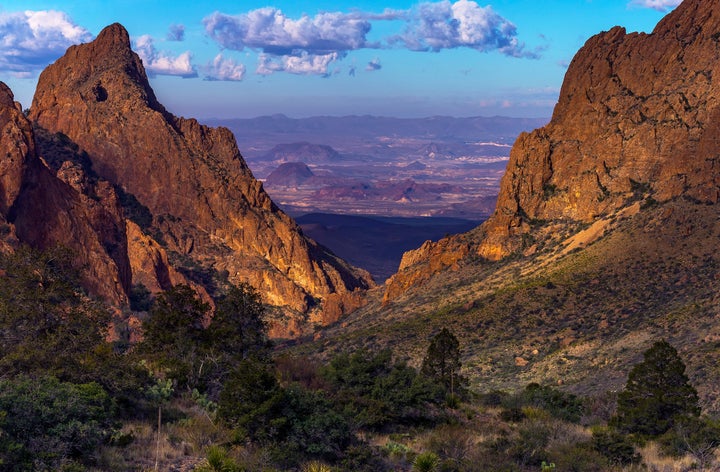
“Big Bend National Park in West Texas is a massive park that borders the Rio Grande River and Mexico, and makes for a great winter visit,” the Wrights said. “The summer temperatures will have abated, making it a perfect time to hike or stroll through a unique mountain landscape that formed from volcanic activity 35 million years ago.”
Winter is part of the park’s high season, so make sure you plan ahead if you want to camp or stay at the lodge.
“In particular, skygazing is perfect at this time of year,” the Wrights noted. “If you are into astral photography or simply enjoy being absorbed by the night sky in an amazing location, Big Bend National Park is an official International Dark Sky Park. With the timing of winter sunsets, stargazing can start before 8:00 p.m.”
Travel blogger Renee Hahnel also advised taking advantage of the winter weather conditions in southwest Texas.
“It can get really hot in Big Bend National Park, so visiting during winter is optimal,” Hahnel said. “There’s tons to do, including hiking, sightseeing, bouldering, scenic drives, and soaking in hot springs.”
Bryce Canyon National Park
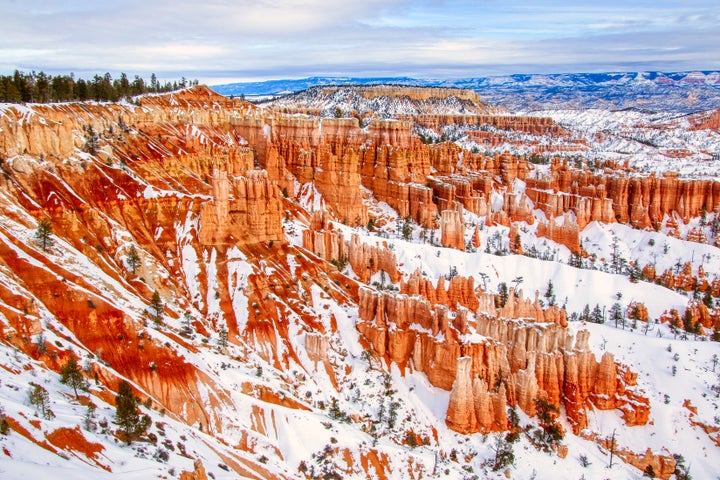
“The hoodoo-spired landscape of Bryce Canyon National Park adds another dimension entirely when snow falls on its peaks,” said James Brockbank, founder of The Family Vacation Guide.
Beyond the magical vibes, you won’t have to contend with crowds and struggle to find parking during the low winter season, and there are still plenty of activity options.
“The red rock amphitheater remains open year-round, and families can head to popular lookouts such as Sunset Point or hike recommended routes including the Navajo Loop and Queen’s Garden trails,” Brockbank said. “There are a multitude of things to do ― from daytime hiking, ice fishing and snowmobiling to a nightfall stargazing and camping experience for families. Its photogenic landscape makes for a great excuse for sightseeing and plenty of photo opportunities to cherish for life.”
Acadia National Park

“Acadia National Park is typically covered in 5 feet of blanketed snow during the colder months,” Brockbank said. “The park contains the tallest mountain on the Atlantic coast of the U.S. Great for cross-country skiers that can enjoy a 45-mile stretch of carriage roads.”
Parkgoers can grab a hot chocolate and explore the nearby Mount Desert Island town of Bar Harbor, Maine, before and after their Acadia adventures.
“The park is rich in human history dating back 10,000 years,” Brockbank said. “Here you can include your kids of all ages, as there are a plethora of child-friendly excursions for educational purposes along with fun-filled activities.”
From snowshoeing to snowmobiling to ice fishing, the options are vast.
Death Valley National Park
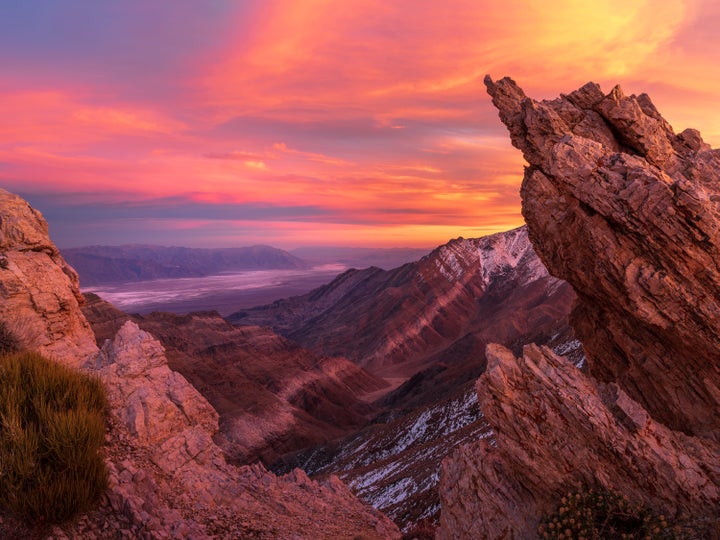
“Winter is the prime time to visit Death Valley National Park,” said Janel Jensen, program manager for adventure travel at REI. “Temperatures are usually mild (for the ‘hottest place on Earth’), and there are good opportunities to still soak up some sun.”
The snow-capped peaks and low-angled winter light make for some lovely views, and you can spend more time outdoors than is advisable during the hotter months.
“Hiking is an ideal activity along with cycling the less-trafficked roads during offseason,” Jensen said.
Yosemite National Park
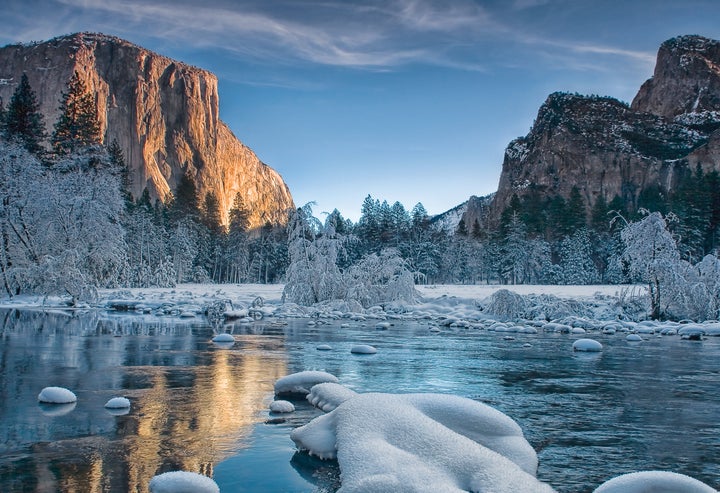
“My favorite winter national park is Yosemite, mainly because the valley and the high Sierra look so gorgeous when covered in snow,” Yogerst said.
He recommended snowy activities like snowshoeing through the redwood groves, family-style downhill skiing or snowboarding at Badger Pass, ice skating beneath the stars at Curry Village, and cross-country skiing along Glacier Point Road.
“Yosemite National Park is one of the busiest national parks during the warmer months, so visiting during winter is a great time to escape the crowds,” Hahnel said. “I recommend traveling with tire chains, unless you have a 4×4 vehicle and winter tires. The roads can get icy!”
Photography enthusiasts will also enjoy the season’s low lighting and easy wildlife spotting, added Jensen.
“Yosemite National Park is a winter wonderland of iced granite peaks, snow-topped giant sequoias and snow blanketing the valley floor,” she said. “My favorite snowshoe trip is from Badger Pass to Dewey Point, where you are rewarded with one of the best views of the valley and El Captan and Half Dome on a clear day.”
Zion National Park

“Winters in Zion National Park are spectacular,” Jensen said. “The potential fresh snow on the landscape adds a dramatic contrast to the already unique scenery and the noise-dampening quality of snow makes this less crowded season that much more peaceful.”
She touted the crowd-free solitude of Zion in the winter and variety of hiking options open year-round due to the low elevation and mild conditions.
“Take in breathtaking views of snow-dusted cliffs contrasted against the warm orange tones of Zion Canyon,” Jensen recommended. “Hike to Observation Point, exploring slot canyons along the way and incredible views of iconic Angels Landing. It’s easier to see wildlife this time of year as they move to lower elevation. Wild turkeys, bald eagles, elk and bighorn sheep are a few of the resident wildlife.”
Credit: Source link